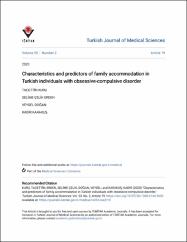| dc.contributor.author | Kuru, Tacettin | |
| dc.contributor.author | Çelik Erden, Selime | |
| dc.contributor.author | Doğan, Veysel | |
| dc.contributor.author | Karakuş, Kadir | |
| dc.date.accessioned | 2023-07-28T12:37:17Z | |
| dc.date.available | 2023-07-28T12:37:17Z | |
| dc.date.issued | 2023 | en_US |
| dc.identifier.uri | https://www.scopus.com/record/display.uri?eid=2-s2.0-85159188618&origin=resultslist&sort=plf-f&src=s&nlo=&nlr=&nls=&sid=20c4fe371b9b908d4f7e419f791331ff&sot=aff&sdt=cl&cluster=scofreetoread%2c%22all%22%2ct&sl=72&s=AF-ID%28%22Alanya+Alaaddin+Keykubat+University%22+60198720%29+AND+SUBJAREA%28MEDI%29&relpos=21&citeCnt=0&searchTerm= | |
| dc.identifier.uri | https://hdl.handle.net/20.500.12868/2296 | |
| dc.identifier.uri | https://journals.tubitak.gov.tr/medical/vol53/iss2/19/ | |
| dc.description.abstract | Background/aim: Family accommodation (FA) is associated with disease severity and response to treatment rates in patients with obsessive-compulsive disorder (OCD) and is therefore particularly important in this patient group. This study investigated the structure of FA and associated factors in a Turkish society sample. Materials and methods: The study was carried out with 92 patients diagnosed with OCD for at least 1 year, who applied to Alanya ALKU Training and Research Hospital psychiatry outpatient clinic between February 2021 and March 2022. Sociodemographic data form, Family Accommodation Scale-Patient Form (FAS-PF), Dimensional Obsessive-Compulsive Scale (DOCS), Beck Depression Inventory (BDI), Beck Anxiety Inventory (BAI) and Acceptance and Action Questionnaire (AAQ-II) were applied to all of the cases. Relatives filled out the Sociodemographic Data. Results: The mean age of the patients was 32.11 ± 11.56 years. Sixty-nine (75%) of the patients were women. Fifty (54.3%) patients were married. All participants reported FA behavior at least once in the previous week. FA exhibited no significant variation by sex (p = 0.679) or marital status (p = 0.256). Significant positive correlation was determined between DOCS-T (r = 0.370, p < 0.001), AAQ-II (r = 0.261, p = 0.013), BDI (r = 0.235, p = 0.024) and BAI (r = 0.342, p = 0.001) scores and the FAS-PF. In the regression analysis, only OCD disease severity predicted FA [(β = 0.295, p = 0.036, 95% confidence interval (95% CI) = 0.02 to 0.55)]. Higher FA scores were obtained in this study (23.93 ± 15.28) compared to previous research in Western societies (14.3 ± 15.2). Conclusion: Clinicians should consider FA in the examination of OCD patients. High FA values for both frequency and severity suggest that interventions directed toward FA may be associated with more positive outcomes in outpatient Turkish patients with OCD. © TÜBİTAK. | en_US |
| dc.language.iso | eng | en_US |
| dc.relation.isversionof | 10.55730/1300-0144.5620 | en_US |
| dc.rights | info:eu-repo/semantics/openAccess | en_US |
| dc.subject | Anxiety | en_US |
| dc.subject | Culture | en_US |
| dc.subject | Depression | en_US |
| dc.subject | Family accommodation | en_US |
| dc.subject | Obsessive-compulsive disorder | en_US |
| dc.title | Characteristics and predictors of family accommodation in Turkish individuals with obsessive-compulsive disorder | en_US |
| dc.type | article | en_US |
| dc.contributor.department | ALKÜ | en_US |
| dc.identifier.volume | 53 | en_US |
| dc.identifier.issue | 2 | en_US |
| dc.identifier.startpage | 594 | en_US |
| dc.identifier.endpage | 602 | en_US |
| dc.relation.journal | Turkish Journal of Medical Sciences | en_US |
| dc.relation.publicationcategory | Makale - Uluslararası Hakemli Dergi - Kurum Öğretim Elemanı | en_US |


















